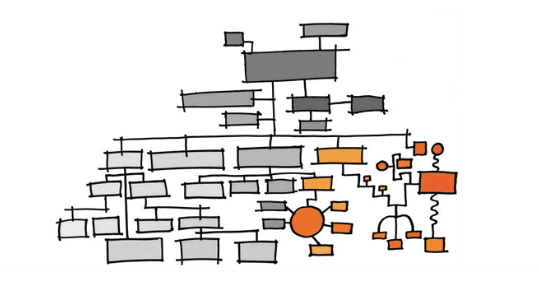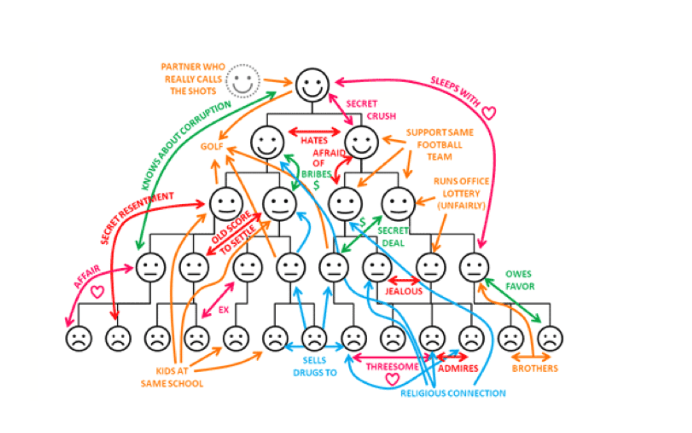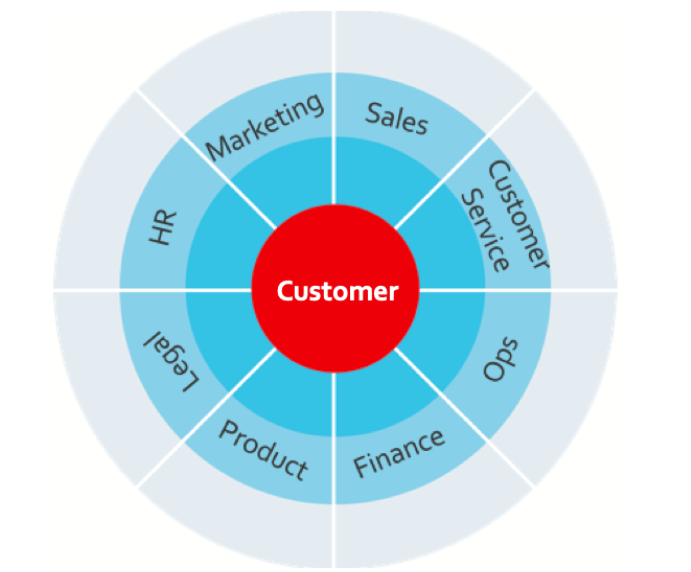No matter what level of work experience you have, we can agree on one thing: office politics SUCK. Perhaps you saw someone’s passive-aggressive note in the kitchen, asking for people to clean up after themselves. Or maybe it was a coworker taking credit for a project you worked on to impress your boss. Nevertheless, these scenarios create toxic work environments and make us hate our jobs.
It doesn’t have to be that way. In Mean People Suck, I explain why the traditional organizational chart doesn’t work. I explain why companies need to shift their focus for happier staff. Hint: the person companies should focus on isn’t on your payroll.
Traditional organizational charts

Organizational charts, or org charts, have existed for more than a century and are a familiar aspect of any business model. The company org chart lays out, in the most basic visual terms, who is below us, who is above us, and who is beside us by connecting all leaders and employees through a series of neat, organized boxes and lines. Without the org chart, supposedly, we would have no clue where employees sit within the greater hierarchy of the company.
Conceptually, org charts help us make business decisions by laying out who is in charge and who decides what we do. They tell us who we direct questions to, who we allocate tasks to, who will be impacted by the decisions we make, and who the decision-makers are in the org chart above us.
An org chart, by design, keeps office life organized and business running smoothly while also motivating those looking to advance their careers by encouraging competition among employees. A little competition between employees can certainly be a good thing; it can inspire new ideas and improve the quality of our work. But sometimes, that backfires.
Why the traditional organizational chart is flawed
However, instead of providing organization in an enterprise, they can sometimes breed dysfunction and create toxic, cutthroat cultures. This may bring out the worst in some of our coworkers, particularly those who care only about getting to the top. Those employees will do whatever’s necessary to get ahead, even if it means forgoing teamwork for personal accomplishment.
It’s even worse when the employee-focused only on moving up is the boss because his or her employees will take all the flak when things don’t go the boss’s way. When competition creates that type of work atmosphere, the quality of our work life inevitably suffers.
Another problem with the traditional org chart is that it almost exclusively encourages upward communication since collaboration and communication with our peers come with the risk of giving them a leg up. Given the nature of the power structure, employees tend to see only the opportunity for vertical growth, leaving little reason to communicate good ideas with peers in other parts of the company. Sharing ideas puts our own recognition at risk.
Org chart reality
The truth is that in my 53 jobs and working closely with countless companies as a consultant, I’ve never seen a company that fits the model laid out on the traditional org chart. Things shake out much differently in the disruptive and innovative world in which we live today. Also, unspoken rules often contribute to the hierarchy of an organization.
If I were tasked with creating an org chart that accurately represents what goes on in a company between everyone who works there, one that details the complicated relationships and power structures that play out every day, I can imagine what that org chart would look like.
At the top might be an executive who has a silent partner who really calls the shots. Maybe a few people know about a senior VP having an affair with someone in the company. There are the inevitable secret crushes that can happen when you bring human beings together in any organization.
This org chart reflects the nature of human beings: it’s messy and complication. It looks something like this:

A singular focus
Another, arguably more significant, problem with the org chart is that it doesn’t include the most important person in any business: the customer. It doesn’t make sense not to include this essential aspect of any company. In a world where companies must prove to be customer-centric more than ever, this oversight is egregious. Businesses exist only because of their customers; therefore, no matter the department, all jobs are customer service jobs.
However, shifting the company’s focus is more complicated than it sounds, especially in large organizations. Inevitably departments in large organizations tend to think of their role in the company in silos, making it hard to get everyone focused on the same goal. Some managers approach it by asking their staff to read a book, but I can almost guarantee you that it doesn’t work.
To truly foster a culture of empathy and prevent misguided or competing priorities, we first need to break the silos throughout our organizations. This means companies ensure that all departments focus their efforts on the customer, and all company goals keep the customer experience in mind. One simple way to accomplish that is to rethink the way the org chart is designed
I call this new type of org chart design, “The Bullseye.”

Simply put, the Bullseye reminds all employees why they’re at work and who they need to serve. Because its design is a target instead of a vertically designed hierarchy, it breaks up tension between peers. No matter their role, it directs every employee’s focus on the same center target point, motivating all employees to concentrate on the same goals and the same priority.
The customer-centered org chart also promotes more communication flow in all directions, as opposed to encouraging cutthroat upward mobility. Using the Bullseye chart can shift how your company manages its goals and how it relates to its customers. As a result, the company’s hierarchy becomes more unified. This real org chart becomes less political, less messy, and less difficult to navigate.
Change starts with you
A change like this takes time and requires buy-in from every level of an organization. This can seem impossible, especially if you are not the CEO. Maybe you think your boss won’t go for it. That’s fine. It can start with you shifting your mindset. After all, no one wants to work for a company that sucks.


You are totally correct and in healthcare the bullseye is the patient!
AYdiWVlqHt
Your article helped me a lot, is there any more related content? Thanks!
Thank you for your sharing. I am worried that I lack creative ideas. It is your article that makes me full of hope. Thank you. But, I have a question, can you help me?
Thanks for sharing. I read many of your blog posts, cool, your blog is very good.
I am really inspired with your writing abilities and also with the layout to your blog.
Is this a paid topic or did you modify it your self? Anyway stay up the
nice quality writing, it’s uncommon to peer a nice weblog like this one today.
Madgicx!
We stumbled over here from a different web page and thought I might as well check things out.
I like what I see so now i’m following you. Look forward to
going over your web page again.
Stop by my web page … nordvpn coupons inspiresensation
You ought to be a part of a contest for one of the best blogs on the web.
I’m going to highly recommend this blog!
Look at my webpage; nordvpn coupons inspiresensation (http://In.mt)
It’s a shame you don’t have a donate button! I’d certainly donate to this brilliant
blog! I guess for now i’ll settle for book-marking and adding your
RSS feed to my Google account. I look forward to fresh updates and
will share this site with my Facebook group. Chat soon!
my web-site – nordvpn coupons inspiresensation
Do you have a spam issue on this blog; I also am a blogger, and I was curious about your
situation; we have created some nice methods and we are looking to trade methods with others, please shoot me an e-mail if interested.
my website nordvpn coupons inspiresensation (t.co)
Nordvpn Special Coupon Code 2025
350fairfax
Hello Dear, are you really visiting this web page daily,
if so after that you will without doubt take fastidious knowledge.
Thank you for your sharing. I am worried that I lack creative ideas. It is your article that makes me full of hope. Thank you. But, I have a question, can you help me?
I don’t think the title of your article matches the content lol. Just kidding, mainly because I had some doubts after reading the article. https://accounts.binance.info/register?ref=P9L9FQKY